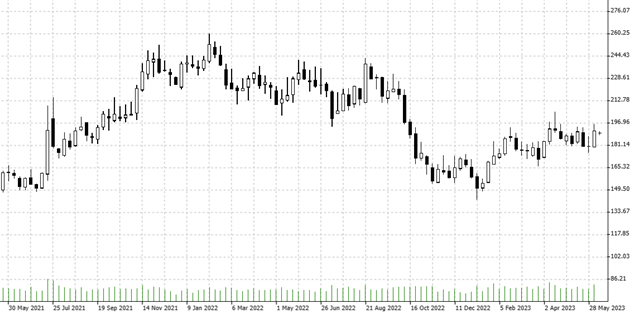

12.06.2023 – Robusta coffee has just set a new price record. Now it could be that Arabica will soon follow suit.
We recently pointed out the possibility of a new coffee boom in the wake of El Niño. With Robusta it was just so far. As Bloomberg news agency reported over the weekend, fears are spreading in the market because of El Niño that the two major Robusta exporters, Vietnam and Indonesia, are facing supply problems – pushing the price of the variety to an all-time high. Specifically, $2,790 per ton, meanwhile ran into a short reset. In Vietnam, increased heat is expected, Indonesia reported an expected minus in the harvest of 18 percent due to unusually heavy rainfall.
Arabica has still not been affected. But we ask ourselves: How long will this situation last? Here is the weekly chart in cents per pound.

Source: Bernstein Bank GmbH
So to the background. The German Weather Service clarifies, “El Niño is understood to be a circulation anomaly that was originally considered to be only a regional climate phenomenon that occurred along the tropical west coast of South America.” But, he said, El Niño also has global impacts, with the phenomenon occurring about every three to four years.
Erratic weather patterns
The National Oceanic and Atmospheric Administration’s Climate Prediction Center had issued a warning in April that the phenomenon could form in the Pacific Ocean this summer. It could cause drought in some regions and increased rainfall in others. The Climate Prediction Center raised the probability of the formation forming between August and October from 61 to 74 percent.
The question now is how much the uptick in prices for the Robusta variety will affect its big brother, Arabica. Robusta represents about 30 percent of the world market; the bean is more bitter, woodier and contains less sugar. Arabica represents about 70 percent of the supply. Robusta tends to be grown in the lowlands in large plantations, while Arabica tends to be grown above 600 meters in farms that are more difficult to manage.
Possible price surge
Due to inflation with higher energy costs and increased prices for fertilizers, many roasters had increasingly switched to the normally 40 to 50 percent cheaper Robusta variety in their coffee blends in recent months. The price gap has now narrowed to around one third.
Our conclusion: Traders in Arabica should keep an eye on the real-time news on El Niño. It is quite possible that there will be catch-up effects in Arabica. After all, a declining supply of Robusta is likely to cause many wholesalers to switch, at least if the price gap between the two varieties continues to shrink. Especially since Arabica is more appreciated by connoisseurs anyway because it contains less caffeine and chlorogenic acid, which makes for an upset stomach. In addition, the weather phenomenon could also affect the major Arabica producer Brazil, which would also push up prices for Arabica.
And another important factor: the capricious weather could also lead to tighter supplies of other soft commodities. Whether long or short – Bernstein Bank wishes successful trades and investments!
________________________________________________________________________________________________________________
The content of this publication is for general information purposes only. In this context, it is neither an individual investment recommendation or advice nor an offer to purchase or sell securities or other financial products. The content in question and all the information contained therein do not in any way replace individual investor- or investment-oriented advice. No reliable forecast or indication for the future is possible with respect to any presentation or information on the present or past performance of the relevant underlying assets. All information and data presented in this publication are based on reliable sources. However, Bernstein Bank does not guarantee that the information and data contained in this publication is up-to-date, correct and complete. Securities traded on the financial markets are subject to price fluctuations. A contract for difference (CFD) is also a financial instrument with leverage effect. Against this backdrop, CFD trading involves a high risk up to the point of total loss and may not be suitable for all investors. Therefore, make sure that you have fully understood all the correlating risks. If necessary, ask for independent advice. CFDs are complex instruments and are associated with the high risk of losing money quickly because of the leverage effect. 68% of retail investor accounts lose money trading CFD with this provider. You should consider whether you understand how CFD work and whether you can afford to take the high risk of losing your money.7
